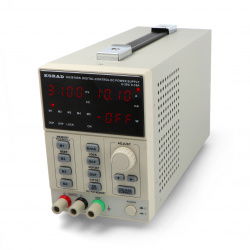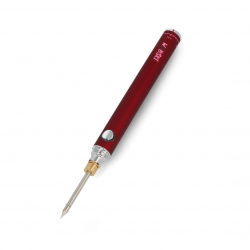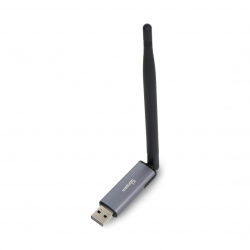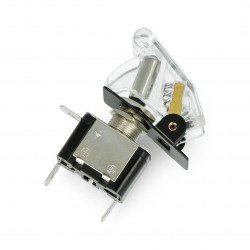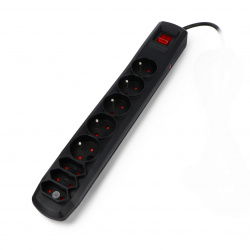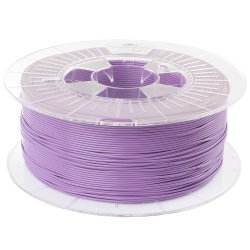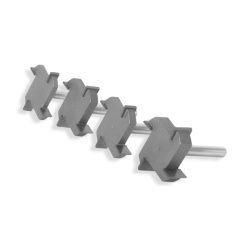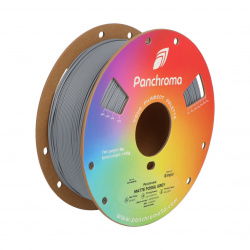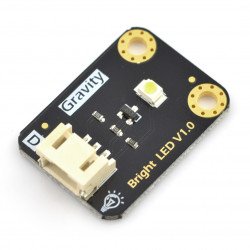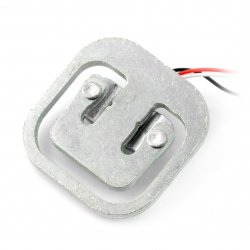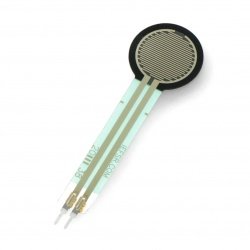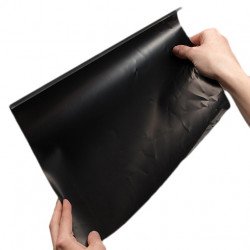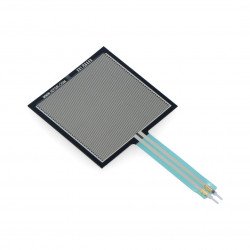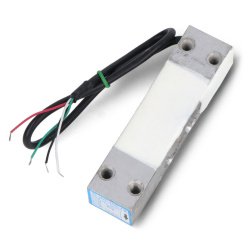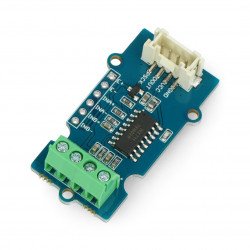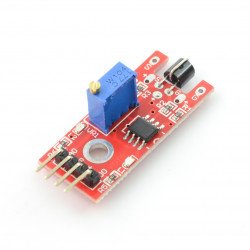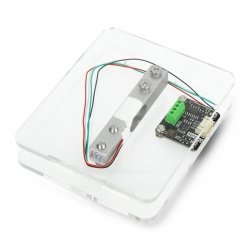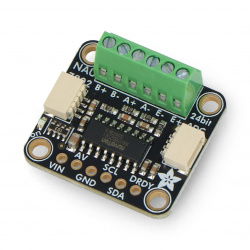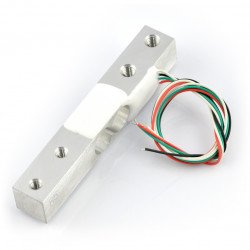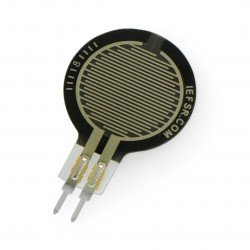Pressure sensors (also known as strain gauges) are devices that convert mechanical energy into electrical energy. The process occurs by detecting the pressure force that is exerted on the surface. This force is then converted into an electrical signal (current or voltage). The value of the electrical signal is relatively proportional to the pressure force.
Pressure sensors
Strain gauge sensor presure force of 50kg
The pressure sensor reduces its resistance when the force put to the square tip, increases. The sensor in the form of a rectangle with the side of 34 mm. For the operation...HX711 - amplifier for tensometers
Operational amplifier is designed to handle strain beams. The system is supplied with the voltage from 2.6 V to 5.5 V, communicates via a two-wire bus: the data line and a...Force sensor FSR-400 - 2kg round 5mm - Pololu 1695
The force sensor reduces its resistance when the force put to the round tip, accumulates. The sensor is round with a diameter of 5 mm.Force sensor FSR-402 - 2kg round 18mm - Pololu 1696
The pressure sensor reduces its resistance as the force applied to the round tip increases. Round sensor with a diameter of 18 mm.Tension beam YZC-1B (97) 40kg (400N)
A load cell operating up to 40 kg (approx. 400 N). Used for kitchen scales and portable scales, for example. The connecting cable has stripped ends and is 32.5 cm long.Mini Scales Unit - Pressure sensor up to 5kg - HX711 - expansion module Unit - M5Stack U177
Mini Scales Unit is an integrated miniature scale that combines a weighing sensor with a 5 kg range , an ADC acquisition system ( HX711 ) and a microprocessor for direct...The conductive membrane for measuring the pressure of the force - Adafruit 1361
The membrane is made of a conductive material. The pressure, at any point, changes the resistance, which leads to the measurable change of the voltage in a simple way. The...Deflection sensor 73x6,3mm - SparkFun SEN-10264
During the bending, sensor increases its resistance. It can be used to detect hand movements, for example, crimping fists. Sensor length is 55 mm.Weight I2C Unit - ADC converter for pressure sensors - HX711 - Unit extension module - M5Stack U180
The I2C pressure sensor with the STM32 system is an advanced module for precise measurement of pressure force . Thanks to the use of the HX711 ADC converter with a...Pressure sensor cell 50kg - 4pcs.
Pressure sensor reduces its resistance when the force put to the square tip, increases. The sensor is in the form of a rectangle with sides of 33 mm. The set has 4 pieces,...Force sensor FSR-406 - 2kg square 38mm - Pololu 1645
Force sensor changes its resistance when the force applied to the square tip, increases. The sensor in the form of a rectangle with side of 38 mm.FlexiForce Pressure Sensor - 25lbs. (1" area) - SparkFun SEN-11207
Pressure sensor reduces its resistance when the force put to the round tip, increases. The round sensor with a diameter of 25.4 mm, the maximum pressure is 11 kg.Tensometric beam NA1 8kg (80N)
Strain-gauge beam operating in the range of up to 8 kg (80 N approx.). It is applied, for example, for kitchen scales, portable scales. The connecting cable has tips with the...Qwiic Scale - NAU7802 module for tensometric beam - SparkFun SEN-15242
The module is based on a NAU7802 system enabling the reading of data from a strain-gauge beams. By connecting the model to the microcontroller, you can read the change in...Grove - ADC converter for HX711 load cell sensors - Seeedstudio 101020712
Arduino compatible 24-bit ADC converter module allows to read values from pressure sensors. It has built-in amplifier with optional 32 dB, 64 dB and 128 dB gain. On the board...Tensometric beam NA1 20kg (200N) - 0,5m
Strain gauge beam operating within the range up to 20 kg, (approx. 200 N). Used e.g. for kitchen scales, portable scales. The connection cable is terminated with terminals with...- Sale
- SPECIAL OFFERS
Stretch sensor - conductive rubber sheet - 200x200x1mm - Adafruit 5463
Tensile sensor in the form of a rubber sheet with dimensions of 200 x 200 x 1 mm. The principle of operation is very simple - the product increases its electrical resistance...Gravity - 1 kg (10 N) digital pressure sensor - HX711 - Build a scale kit - DFRobot KIT0176
A set of elements for self-assembly , which allow to make an electronic balance . The kit contains a digital pressure sensor, in the form of a strain gauge bar, detecting...Strain Beam Module - with 24-bit ADC NAU7802 - STEMMA QT / Qwiic - Adafruit 4538
This Adafruit module, equipped with the NAU7802 , allows you to read data from strain gauge beams . It includes a very high-resolution 24-bit differential ADC with...Tensometric beam NA27 1kg (10N)
Strain-gauge beam operating in the range of up to 1 kg (approx. 10 N). The smallest version is used, for example, in kitchen scales, portable scales. The connecting cable has...DFRobot Gravity - digital pressure sensor 1kg (10N)
Pressure sensor for Arduino works in the range of up to 1 kg. It is based on HX711, it has 24-bit analog-to-digital converter designed to scale weight and control applications...Force sensor round 15mm - short connector - Pololu 2728
Pressure sensor reduces its resistance when the force put to the round tip, increases. The s ensor with the short connector, round, with about 15mm diameter.Rubber conductive rubber cable for measuring the tensile force - Adafruit 519
Conductive rubber wire with a diameter of 2 mm and a length of 1 meter. It is used to measure the stretching strength. During the stretching of the element, its resistance...See also
- Piezoelectric sensors
- RPM sensors
- Twilight sensors
- Tilt sensors
- Accelerometers
- Inductive sensors
- Hall effect sensors
- Oxygen sensors
- Optical sensors
- Resistance sensors
- Door sensors
- Alarm sensors
- 9DoF IMU sensors
- Pressure sensors
- Air quality sensors
- Sound sensors
- Gesture sensors
- Gas sensors
- Limit switches
- Sensors of light and color
- Magnetic sensors
- Medical sensors
- Sensors odbiciowe
- Distance sensors
- Inductive contactless sensors
- Weather sensors
- Liquid level sensors
- Current sensors
- Flow sensors
- Motion sensors
- Temperature sensors
- PT100 temperature probes
- Humidity sensors
- Fingerprint readers
- Encoders
- Photoresistors
- Phototransistors
- IR receivers
- Magnetometers
- Gyros
- Sensor sets
- Grove modules
- Gravity modules
Principle of operation of pressure sensors
The resistive pressure sensor (FSR) consists of two layers electrically insulated from each other. When a pressure force is applied to the outer layer in the form of a foil membrane, the insulating cover presses against the active layer, which is lined with electrically conductive measurement points. The greater the pressure force, the lower the contact resistance between the measurement points. The conductive layer is connected to a power source with auxiliary voltage, and the voltage signal, which reflects the applied pressure force, can be read, e.g. by Arduino, via an analog-to-digital converter and, based on the program algorithm, converted into the value of the weight exerted on the surface of the load cell. The measurement result can be displayed on the LCD display.
Important tips for installing strain gauges
Flat FSR sensors are made of very delicate material and great care is required when installing them. At the prototyping stage, it is easiest to connect such a sensor to the breadboard directly, or using crocodile clips or an ARK connector with screw terminals. However, if you want to solder the pressure sensor to the PCB, you must ensure that the soldering tip and the soldering surface are clean, because even within a few seconds the layers of the sensor may melt, causing permanent damage.
The compensating strain gauge is used to measure the pressure force taking into account the influence of external factors, primarily air humidity, temperature and atmospheric pressure.
The correct operation of the strain gauge sensor can be checked by supplying it with the appropriate voltage at nominal load and reading the output voltage value with an electric meter .
The resistance strain gauge uses the phenomenon of changing electrical resistance when changing the dimensions of the resistance material . Such devices are used, for example, to measure stress or pressure, for example in loading systems.
































































































































































































































































































































